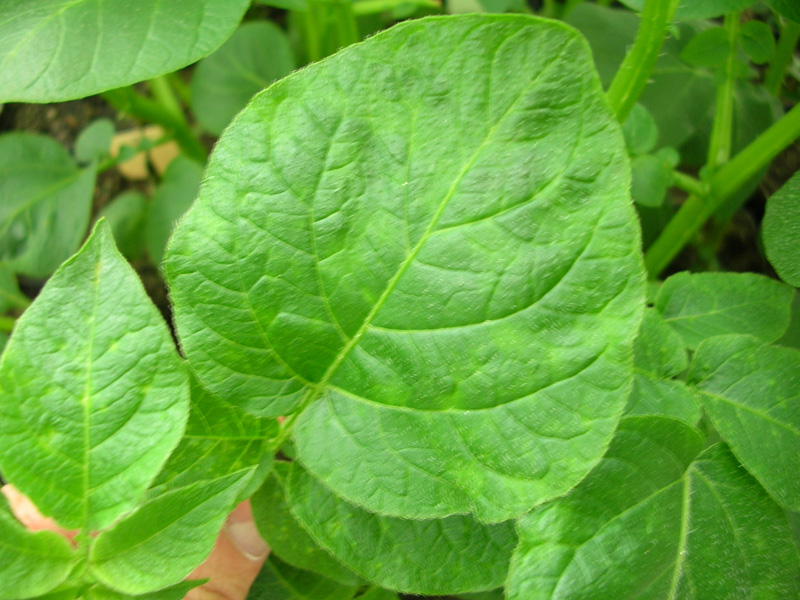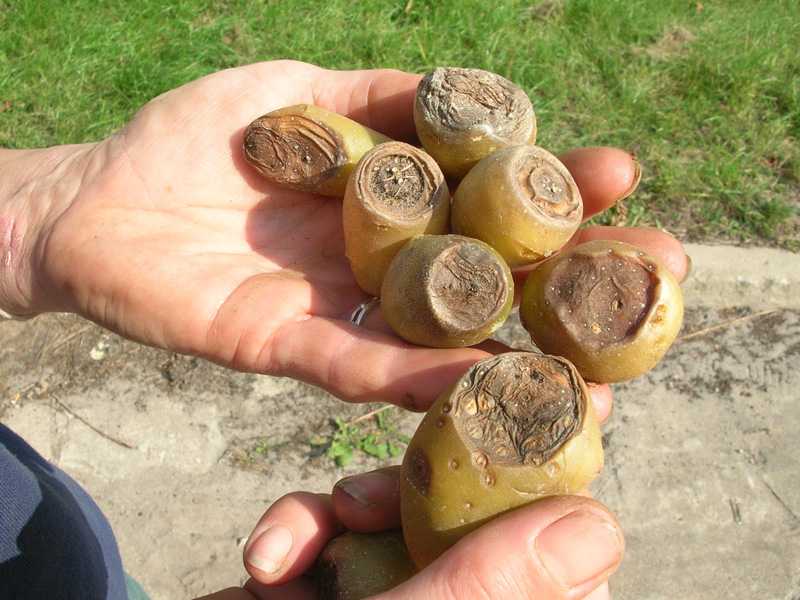Polish name: Wirus S
English name: Potato virus S, PVS
Kod EPPO: PVS000
Gallery

Light mosaic and slightly indented veining on the leaf may indicate infection with PVS
(photo: S. Wróbel).

Damage to tubers due to improper use of products containing diquat
(photo: S. Wróbel)

Damage to tubers after improper application of products containing diquat
(photo: S. Wróbel)
Characteristics and description of the disease
The S virus is widely spread globally, including in Poland. It was first described in the Netherlands in 1952. One of the strains, called Andean (PVSA), is classified as a quarantine organism in the European Union. In Poland, two strains of the S virus are known: PVSO, the common strain, and the aforementioned Andean strain (PVSA), which has not been detected in Poland so far. The S virus belongs to the Carlavirus genus of the Flexiviridae family. It has not been significant in potato production in Poland, including seed production, due to the lack of standardization of seed material infection by this virus. However, since 2015, all seed materials in Poland are evaluated for infection by six viruses, including PVS.
The main source of S virus infection is seed potatoes. It is primarily transmitted from infected plants to other plants by aphids, but with mechanical damage to plants, it can also be transmitted mechanically with their sap. The main aphid species in Poland include the nasturtium-potato aphid (Aphis nasturtii), the peach aphid (Myzus persicae), and many non-potato aphids, such as the bean aphid (Aphis fabae), which, although not a host plant for potatoes, can transmit the virus while searching for a suitable plant. A few seconds of probing is sufficient for aphids associated with potatoes to effectively transmit the virus, with the optimum time being 30 seconds to 2 minutes, similar to PVY and PVM. Additionally, aphids achieved the highest efficiency in transmitting the virus when feeding on a diseased plant for only 15 seconds.
Recent studies conducted in the USA indicate that potato plants infected with PVS are much more susceptible to infection by Phytophthora infestans. Older research suggested that plants with PVS were less likely to acquire other viruses, such as PVY and PVX. However, the presence of PVS in complexes with PVA, PVX, or PVY enhances the symptoms of infection by these viruses on plants. Therefore, the presence of this virus in a plant also has positive aspects.
Although the S virus is widespread in Poland, it belongs to a group of viruses with very little economic importance. Potential yield losses do not exceed 10%, and this applies only to varieties highly sensitive to infection, which are not commonly found in Poland. The latest foreign scientific publications indicate that this level generally does not exceed 5-8%. Legal regulations specify the maximum infection of seed potatoes by viruses for different qualification classes. In the Czech Republic, due to its low harmfulness, the detected infection is multiplied by a factor of 0.05. In Poland, there is no such reduction in its role, and the actual proportion of tubers infected with the virus is taken into account. The highest allowable proportion of tubers infected with viruses, including PVS, cannot exceed 10% for Class B.
Symptoms of infection:
It is very difficult to diagnose visually on plants because it does not exhibit as clear symptoms as other viruses. Symptoms are challenging to observe in field conditions, and they are easier to detect when healthy plants of the same variety are nearby. However, infection often occurs without visible symptoms. Therefore, the only reliable method is laboratory assessment using the DAS ELISA test and more sensitive tests such as PCR or its variants. The most commonly occurring symptoms on plants during vegetation are:
- Slightly lighter color of plants and slightly sunken veining (photo 1S),
- Mild deformation of the edges of upper leaves,
- Chlorotic or weakly necrotic symptoms on lower leaves. These leaves are often prematurely yellow, sometimes with a coppery hue, with chlorotic patterns or green spots on a yellowing background.
Methods of protection:
One way is to plant resistant varieties. Due to its low economic importance, Poland does not assess the degree of resistance or disease symptoms caused by this virus on newly introduced varieties into the National Register. Therefore, many varieties do not have defined resistance to it. Although resistance breeding is not conducted for this virus in Poland, there are resistant varieties that possess the NS resistance gene, derived from initial materials produced at the IHAR-PIB branch in Młochów.
There are no effective means to directly combat viruses. Their spread can only be limited. The most effective treatment is to use the greatest spatial isolation (distance from other potato plantations). This is currently most important for protecting healthy seed potatoes from infection originating from plantations of unknown health status. These are usually potatoes grown for many years exclusively from their own propagations.
In addition, sources of infection, i.e., plants infected with viruses, should be removed from the field along with the tubers. This is known as negative selection. However, it is essential not to be too conservative because leaving a suspicious plant in the field in the hope of obtaining higher yields can result in the virus spreading to neighboring plants and, consequently, in the case of seed plantations, degradation or even disqualification.
Controlling aphids on the plantation aims to limit the number of potential vectors (virus carriers). This treatment is most effective in limiting the spread of leaf roll virus (PLRV). Much less effectiveness is achieved for viruses transmitted during probing, so-called non-persistent viruses – PVY, PVM, PVS, PVA. However, if diseased plants (virus-infected) are growing in or near the plantation, chemical protection is usually ineffective. The number of aphid control treatments depends on the earliness of the variety and the intensity of aphid occurrence. Typically, 2 to 5 treatments are applied. By treating potatoes with Prestige Forte 370 FS, you can delay the first treatment due to the insecticidal action of this agent for the first 6-8 weeks after planting. Additionally, this agent protects the plantation against the Colorado potato beetle and soil pests.
A highly effective method for limiting the spread of PVS is the use of mineral oil, similar to PVY and PVM. To achieve the desired effectiveness, mandatory weekly oil sprays (e.g., Olemix 84 EC, Sunspray 850 EC) should be applied. Treatments should begin when about 80-90% of the plants have emerged in the plantation. The recommended oil dose is 7 l/ha. This is currently the only very effective chemical method of limiting the spread of PVS on potato seed plantations. In commercial production, it is much cheaper to exchange seed material every 2-4 years with healthy qualified material.
A highly effective method for limiting the movement of viruses from above-ground parts to tubers is the early destruction of haulms. This treatment is commonly performed on seed plantations. In commercial production, its effectiveness in reducing tuber infection with the S virus is significantly lower due to the significantly later timing of its implementation – the end of vegetation.
In practice, three methods are used:
Mechanical method:
The mechanical method involves physically crushing the above-ground parts of the potato. Special 2-, 4-, or 6-row devices, attached to the tractor’s three-point hitch, which are powered by the PTO (photo 1mech), are used for this purpose. The device has a system of rotating prongs (beaters) adapted to the shape of the haulms. It is best to leave stem remnants about 10 cm long. Setting the cutting elements too low can damage the top layer of the haulm, exposing and damaging the tubers. It also promotes secondary plant regrowth, especially in conditions of high humidity (rainfall). This is crucial for seed crops because new regrowth is prone to viral infections. Leaving too long stem remnants significantly prolongs drying time and also promotes regrowth. It is important not to use this method on plantations strongly affected by late blight due to the high risk of spreading spores with plant debris.
Chemical method:
commonly known as desiccation. It involves applying appropriate substances in the form of a spray to plants, causing them to dry up. The application of the substance in inappropriate weather conditions can contribute to defects in tubers. This is particularly important in the cultivation of potatoes for processing (chips and fries). Research from abroad indicates that during prolonged drought, spraying with Reglone 200 SL or its equivalent at the full single dose may cause internal discoloration of the pulp on some varieties. Contact of tubers with this agent can also cause significant damage. Such situations may occur when tubers are very shallowly located in the haulm, and after treatment, intense rain washed the preparation from the stems to the tubers in the soil. For best results, it is recommended to use split doses. The first dose is intended to destroy the upper leaf mass so that the substance can precisely cover the exposed stems during the second treatment. The second half of the recommended dose of the substance should be applied 3-6 days after the first treatment. The absorption rate of substances by leaves and stems varies and depends, among other things, on the soil on which potatoes grow. They are absorbed most quickly by plants growing in heavier soils (clay, loamy sand). In the case of Reglone 200 SL, rainfall 15 minutes after application does not significantly affect its effectiveness, while after applying Basta 150 SL, according to the label, 4 hours of rain-free weather are required.
Mechano-chemical method:
the most favorable method due to the speed of haulm drying and the effectiveness of limiting tuber infection with viruses. It involves combining both methods described above. After breaking the haulms and leaving slightly longer sections of stems (15-25 cm), a desiccant should be sprayed at a reduced dose. Drying of haulms after using this method is the fastest (Fig. 4).
Fig. 4. Rate of haulm drying depending on the applied method (source: S. Wróbel, IHAR Bulletin 237/238/2005)
Prepared by: Dr. Hab. Sławomir Wróbel

